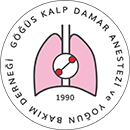

Volume: 26 Issue: 2 - 2020
| 1. | Cover Page I (548 accesses) |
| 2. | Contents Pages II - V (658 accesses) |
| 3. | Publication Policies and Writing Guide Pages VI - XI (581 accesses) |
| RESEARCH ARTICLE | |
| 4. | Efficacy of Epidural Morphine and Paravertebral Catheter in Post Thoracotomy Pain Abdulkerim Bayülgen, Mustafa Azizoğlu, Sungur Selim Sinan, Erhan Ayan, Davud Yapıcı, Mehmet Oğuz Köksel doi: 10.5222/GKDAD.2020.46362 Pages 55 - 61 (1087 accesses) INTRODUCTION: To investigate if paravertebral catheter which is placed under direct vision during surgery is superior to lumbar epidural morphine application. METHODS: The records of 66 patients who underwent thoracotomy between January 2013 and January 2014, who had 34 lumbar epidural catheters and 32 paravertebral catheters and who are meeting the inclusion criteria were evaluated retrospectively. From the patients files pain scores (Verbal Rating Scale) at postoperative 0, 1, 4, 12 and 24 hour were recorded during both resting and coughing. In addition, heart rate, blood pressures, respiratory rate, saturation, thoracic drain withdrawal times and postoperative complications were recorded at the same postoperative hours. RESULTS: Demographic and operative data of patients in both groups were similar. In terms of postoperative pain, Verbal Rating Scale was similar in both groups at all measurement times. There was no statistically significant difference between the two groups in terms of postoperative complications. DISCUSSION AND CONCLUSION: The paravertebral catheter which is placed under direct vision during thoracotomy provided the same level of analgesia as the lumbar epidural morphine administration. We believe that the paravertebral catheter may be an alternative method to epidural due to its effective analgesia and safely application. |
| 5. | Comparison of Myocardial Metabolism and Apoptosis in Patients Undergoing CABG Operation Performed Either with Fibrillation or Cardioplegia Method Hija Yazicioglu, Ali Ihsan Parlar, Sevil Tokat, Büşra Tezcan, Ahmet Tulga Ulus doi: 10.5222/GKDAD.2020.06977 Pages 62 - 70 (853 accesses) INTRODUCTION: Optimal myocardial protection during CABG operations is still controversial. In this study we compared hemodynamic data, myocardial oxygen extraction, lactate production and apoptosis in transmural biopsy specimens in operations done either with intermittent aortic cross-clamping with fibrillation (IAC) or with cardioplegic cardiac arrest (CCA) method. METHODS: Following Ethics Committee approval, consecutive patients with normal ventricular function and no comorbid disease other than regulated hypertension and/or type-2 DM were included in the study (IAC group n=13, CCA group n=8). Hemodynamic data, serial CK-MB values and ECG changes were recorded till postoperative 24 hours. Myocardial oxygen extraction and lactate production were calculated from the blood samples withdrawn from the aortic root and the coronary sinus cannula during following periods; before total CPB, during cross-clamp and following cross-clamp removal. Transmural biopsy specimens obtained before total CPB and before cessation of CPB were analyzed for apoptosis. RESULTS: Demographic and hemodynamic variables were similar. Preischemic and postischemic myocardial oxygen extraction and lactate production values showed no significant differences. Seven patients in IAC and one patient in CCA group needed low dose inotropic support during early postoperative period. Biopsies revealed no evidence of apopitosis in both groups. DISCUSSION AND CONCLUSION: This study shows that for low risk CABG procedures, IAC and CCA methods were no superior to each other in protecting the myocardium from ischemic injury with respect to myocardial oxygen extraction, lactate production and presence of apoptosis. |
| 6. | Atrial Fibrillation After Coronary Artery Bypass Surgery: Risk Factors Oya Karakaş, Nurgül Yurtseven, Dilek Savaskan doi: 10.5222/GKDAD.2020.41033 Pages 71 - 79 (1609 accesses) INTRODUCTION: The aim of this study was to determine the risk factors in Atrial Fibrillation (AF), which is the most common rhythm disorder observed after coronary artery bypass graft (CABG) surgery, and to show whether there is a correlation between C-Reactive Protein (CRP) and AF. METHODS: 250 patients who underwent coronary artery surgery were prospectively included in the study. Demographic data, peroperative and postoperative variables of all patients, daily CRP and AF follow-ups until the 6th postoperative day and treatment protocols of AF patients were recorded. RESULTS: AF was detected in 43 (17.2%) of the patients who were followed up. It was found that there was a statistically significant relationship in the multivariate analysis between advanced age, hypertension (HT) and use of preoperative calcium channel blocker and AF(p<0.05). CRP values reached the highest value on the 2nd postoperative day. Although AF was seen in 14 patients (5.6%) in this period, no relation was found between the height of CRP and the development of AF(p>0.05). It was observed that the duration of intensive care and hospital stay of patients with AF was statistically significantly longer (p <0.05). DISCUSSION AND CONCLUSION: It was found that patients with advanced age, hypertensive, preoperative calcium channel blocker usage had a higher risk of developing AF. Duration of ICU and hospital stay was longer, and no correlation was found between AF and CRP. |
| 7. | Factors Affecting Intensive Care Unit Stay in Coronary Artery Surgery Songül Kocabaş Güler, Nurgul Yurtseven, İpek Yakın Düzyol doi: 10.5222/GKDAD.2020.34635 Pages 80 - 84 (1103 accesses) INTRODUCTION: Prolonged ICU stay after coronary artery bypass surgery(CABG) is associated with increased morbidity, mortality and hospital costs. The aim of this study is to analyze the risk factors associated with the prolongation of postoperative intensive care stay(ICUS) after CABG operations. METHODS: 199 patients who would electively undergo CABG operation were included in the study. Prolonged ICU stay was determined as 48 hours. Preoperative demographic data, cross-clamp and pump times, inotropic uses, 2> unit blood transfusion, hypothermia, intubation time, arrhythmia, alveolo-arterial oxygen gradient (PAO2-PaO2) and partial arterial oxygen / fractional inspired oxygen (PaO2 / FiO2) ratios were recorded. Patients were divided into two groups according to the length of stay in the intensive care unit. Group1: Patients with ICU stay shorter than 48 hours, Group2: Patients with ICU stay longer than 48 hours. Mann Whitney U test and unpaired t test were used as statistical method. The factors associated with prolonged intensive care were investigated by linear regression analysis. RESULTS: Duration of stay in intensive care unit was 26. ±9.1 in Group1, it was 137.8±72.3 hours in Group2 patients. Ventilation time was calculated as 11.1±4.1 hours in group 1 and 74.5±81.0 in group 2. According to the linear regression analysis, intubation time, chronic obstructive pulmonary disease (COPD), age>60, creatinine>1.3 mg/dl and ejection fraction (EF)<45% were found to be factors associated with prolonged ICU stay. DISCUSSION AND CONCLUSION: In the presence of identified risk factors, the appropriate timing of the operation will be supported by supporting the patients with appropriate treatment options and determining the timing of the operation |
| 8. | Comparison of Regional Cerebral Oxygen Saturation Values by Using Near-Infrared Spectroscopy in Patients who Underwent Coronary Artery Bypass Graft with and Without Internal Carotid Artery Stenosis Hale Kefeli Çelik, Zahide Doğanay, Atilla Kanca doi: 10.5222/GKDAD.2020.94824 Pages 85 - 94 (892 accesses) INTRODUCTION: In the study, the regional cerebral oxygen saturation (rSO2) of patients with and without carotid artery stenosis was monitored to see whether or not NIRS can be used routinely in CABG operations. METHODS: Eighty patients undergoing CABG were divided into two groups. Following the preoperative colour Doppler ultrasonography, the patients with internal carotid artery stenosis or with stable plaque were included in Group I (n=40), while the patients having no internal carotid artery stenosis were included in Group II (n=40). Pulse rates, systolic and diastolic blood pressures, mean arterial blood pressures, nasopharyngeal temperatures, haematocrit, PaO2, PaCO2, SpO2, BIS, right, and left rSO2 values, and relative changes in rSO2 from baseline of the two groups were compared. RESULTS: The male/female ratios in both groups were 27/13. The mean age was 60.82±9.63 (3979) years in Group I and 59.95±9.54 (4180) years in Group II. No differences were observed in terms of demographic data, preoperative laboratory and bispectral index (BIS) values, and time of operation and CPB. In addition, no differences were observed between the arterial blood gas values or the right and left rSO2 values of the groups at all measurement time points (p=0.309 and p=0.114, respectively). In both groups, the decrease in rSO2 values was not higher than 20% at all measurement time points. However, the relative changes in rSO2 from baseline in Group I were statistically different compared to those in Group II (right p=0.031, left p<0.001). No stroke occurred in the groups postoperatively. DISCUSSION AND CONCLUSION: In patients undergoing CABG, brain perfusion reduces when a CPB pump is put into operation, and the monitoring of intraoperative cerebral perfusion with NIRS is crucial. In patients with carotid artery stenosis, relative changes in rSO2 from baseline are higher. |
| 9. | Retrospective Investigation Of Anatomical Localization Preference And Catheter Malposition In Patients With Central Venous Catheterization Harun Özmen, Bahar Aydınlı, Uğur Serkan Çitilcioğlu, Alptuğ Özen, Kamuran Tekin doi: 10.5222/GKDAD.2020.30301 Pages 95 - 101 (1569 accesses) INTRODUCTION: Central venous catheterization (CVC) is an invasive procedure used in intensive care units with various indications. Malposition has been reported in the literature ranging from 3.6-14% in practice. In this study, we aimed to determine the preference of catheter placement and malposition rates in SVC application performed by specialist physicians in our intensive care units without using ultrasonography. METHODS: After the approval of the ethics committee, 1710 patient files were applied to the Mersin City Training and Research Hospital in 2017-2019. Permanent port catheter, dialysis catheter and catheters placed in pediatric patients under 18 years of age were excluded from the study. All catheterization procedures were performed by a specialist physician using 7 F catheters with Seldinger technique without the use of ultrasound. RESULTS: Of the 1463 patients included in the study, 842 patients had internal jugular vein, 467 patients had subclavian vein and 154 patients had femoral vein. When femoral catheterization was excluded, malposition was found in 1309 patients with a rate of 1.68%. There were 14 malposition catheters in the right internal jugular vein, 6 in the right subclavian vein and 2 in the left subclavian vein catheterization. DISCUSSION AND CONCLUSION: In conclusion,it has been reported that ultrasound-guided catheter placement may prevent malposition and reduced complication rate when performed by experienced clinicians. However,when the ultrasound is not available, we believe that performing the procedure by experienced clinicians and confirming the accuracy of the catheter position with lung x-ray after the procedure may reduce malposition rates |
| 10. | Bilateral Erector Spinae Plane Block for Redo Tricuspid Valve Replacement with Thoracotomy Behiç Girgin, Halil İslamoğlu, Aslı Z. Demir doi: 10.5222/GKDAD.2020.42275 Pages 102 - 105 (817 accesses) Erector Spinae Plane(ESP) block in cardiothoracic surgery may be a good alternative to perioperative opioid use or thoracic epidural analgesia in the treatment of postoperative analgesia. We presented to effective ESP block experience for a patient redo tricuspid valve replacement. A patient underwent surgery for redo tricuspid valve replacement(TVR) with thoracotomy. The patient underwent aortic valve replacement in 1994, mitral commissurotomy in 2005 and TVR in 2008. Single injection block was performed at the level of the T5 for ESP with 0.5% bupivacaine saline 1: 1 mixture was bilaterally administered in 20 ml each.On the 1.and 2. postoperative day, VAS was 1-2 and no additional analgesic was required. Single injection block was quite effective in relieving postoperative pain, the patient was hemodynamically stable and minimum perioperative opioid requirement was promising. ESP block is very advantageous in order to avoid problems caused by high opioid doses. An important point is that more tissue resection is required in redo surgeries, causing more pain, however, adequate analgesia was achieved with single injection ESP in our case. |
| CASE REPORT | |
| 11. | Pneumothorax Caused by Airway Extubation Catheter in a Difficult Intubation Case Kezban Aydan Okuyucu, Emine Yurt, Mehmet Yılmaz, Ayşe Adin Selçuk, Kemal Tolga Saraçoğlu doi: 10.5222/GKDAD.2020.72621 Pages 106 - 110 (1466 accesses) In the expected difficult intubation, Awake FiberOptic Nasotracheal Intubation and tube-changing catheter are used. These practices can be life-saving as well as cause some complications. In this case report, a patient with a mouth opening of 0.2 mm due to retromolar mass was subjected to Awake FiberOptic Nasotracheal Intubation for biopsy. A tube changer catheter was used on the extubation. Pneumothorax was observed after extubation. In this case, we present our experience with Awake FiberOptic Nasotracheal Intubation, extubation with airway exchange catheter and developing pneumothorax. |
| 12. | Terlipressin Increases Blood Pressure and Facilitates Weaning from Cardiopulmonary Bypass in Heart Transplant Recipients with Refractory Hypotension: Case Series Aynur Camkıran Fırat, Nukhet Akovalı, Duygu Taşkın, Atila Sezgin, Pinar Zeyneloglu doi: 10.5222/GKDAD.2020.08760 Pages 111 - 112 (969 accesses) Abstract | |
| LETTER TO THE EDITOR | |
| 13. | Factors Affecting Perioperative Blood Transfusion Applications in a University Hospital (Letter to Editor) Seher İrem Kıran, Fevzi Toraman doi: 10.5222/GKDAD.2020.25483 Pages 113 - 114 (783 accesses) Abstract | |

















